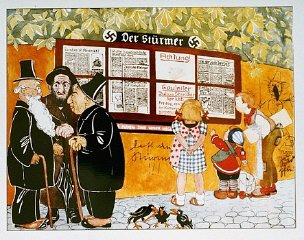"If Kafka's “The Metamorphosis” strikes anyone as something more than an entomological fantasy, then I congratulate him on having joined the ranks of good and great readers…for we can take the story apart, we can find out how the bits fit, how one part of the pattern responds to the other; but you have to have in you some cell, some gene, some germ that will vibrate in answer to sensations that you can neither define, nor dismiss "
(Vladimir Nabokov). Far be it for us to quibble with Nabokov. But agree, with each reader brings different minds which can fabricate different ideas and views of Franz Kafka’s tedious, although clever, fantasy of wordplay. For, literature is only an art that is perceived on an open canvas as the portrayer sees. For instance one artist, Carlos Atanes, an underground filmmaker, adapted in his 1994 “The Metamorphosis of Franz Kafka”; which entwines, loosely, the original story with Kafka’s reality. However, both tails circulate around one meaning
Why do we exist? What does the transformation of Gregor Samsa symbolize?
However, when inquired in different decades the meaning takes on a different sense.
In the original text, “The Metamorphosis”, Kafka paints a scene based out of a dying Central European town in 1912. Based on the speculation that Kafka portrays similar aspect of his own metamorphosis in his analogous story, one could assume the grey town is a shadow of his hometown of Prague. During the early 1900’s, post the rise of capitalism, Prague was a combination of ethical barriers. At the time Prague was segregated by Czechs, Jews and Germans, endeavoring to industrialize the advancing city
(Tramer 305).
As Prague crept into the new age, Kafka described his town as broad modern streets of dreams, disguised with traces of the old ghetto, with its dreary alleys, reeking taverns, ubiquitous corruption to be more real than the palpable for the residents of the new city
(Sokel). Where families struggled to survive, however managed to wear a lucrative mask, Kafka developed early in life an inordinate sense of guilt. The idea of the insolubility of the most ordinary, even human problems depressed his youth and later inspired his art, “The Metamorphosis”
(Phillip Rahv 62).
Assuming that events are symbolic to his life, Gregor is also faced with similar obstacles. In the story the protagonist, Gregor, undergoes a gruesome transformation into a retched dung beetle. With his transformation Gregor became compulsorily distant from his work, society, his family and eventually himself. Which before long has him pondering what he knows, or thought he knew, and asking What is my purpose?. Given the obstructions Gregor faces, the meaning can be concluded that humanity is susceptible to forcibly reforming to an authority. Rather susceptible to settle for an expected job, lifestyle, or accepted idea, Kafka suggests that we are all insects in society, going through the same routine, decade after decade, week after week, day in day out, that eventually the custom becomes instinct.

Throughout history there has been compelling evidence of illicit force being used to reform humanity. For example, during the early 1900’s life for Jews in Prague changed from tolerable to unbearable. This was a result of the uprising of German Nazis in the 1920’s. Reputations of Neo-Nazis racial propaganda ripped through the population of Central Europe, inevitably causing the segregation of communities. With popularity of the regimes fascist views growing, Jewish families living in Prague were stricken of rights and suppressed in the community by their fellow, Czech and German, Spaniards.
“Our personal problem was not, in fact, what our enemies were doing, but rather what our friends did,” stated Hannah Arendt, Jewish German-American political philosopher, to a friend about her escape from a death camp in Germany,1940
(Hannah Arendt). In Carlos Atanes film adaption of Kafka’s original work; that is exactly the lesson Gregor learned. Atanes’ placed the Samsa family right in the middle of late 1930’s fascist tainted Prague. Effects of Jewish segregation faded in and out from outside the family’s house, while inside, a half man half bug, Gregor tries to understand and cope with his unfamiliar form. Gregor’s transformation into an insect, or Ungeziefer, with a human-like appearance also echoes a grim realization of the Jewish torment. Ungeziefer, German for unclean animal not suitable for sacrifice, is a term that the Nazis used to refer to the Jews (Bruce 113).
Gregor’s figure in the causes his family to lose their companionship for him, like the betrayal Jews experienced by their neighbors and friends. After all, how could an unclean animal not suitable for sacrifice really be a human?
Even though both Kafka and Atanes symbolic morphing toys with the question, Why do I exist, what is Gregor’s purpose? The times of the events are different, ultimately causing two different conclusions. In one Kafka suggest the formation of Capitalism and falling into uniformity. However, Atanes implies the same meaning; he strengthens it by adding symbolism of the Jewish population’s suppression by society during the German reign. Given each portrayal of “The Metamorphosis” the way an artist decides to set the scenery ultimately affects how an audience receives the underling question or meaning.
Work Cited
- Nabokov, Vladimir. “Lecture on "The Metamorphosis" by Vladimir Nabokov” Kafka.org. The Kafka Project, 6 January 2012. Web. 31 May 2012
- Tramer, Hans. “Prague-City of Three Peoples” Leo Baeck Institute Yearbook. 9.1 (2012): 305-339.Web
- Sokel, Walter. “Franz Kafka as a Jew” Leo Baeck Institute Yearbook. 18.1 (2012): 233-238.Web
- Rahv, Phillip. “Franz Kafka: The Hero As Lonely Man” The Kenyon Review. 1.1 (1939): 60-74.Web
- Arendt, Hannah. “Hanna Arendt” fembio.org. Notable.Women.International, Web. 31 May 2012
- Kafka,Franz. Corngold, Stanley. The Metamorphosis: A Norton Critical Edition. W. W. Norton & Company, 1996. Print.












